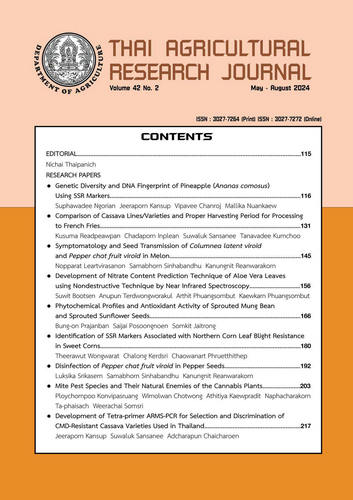Identification of SSR Markers Associated with Northern Corn Leaf Blight Resistance in Sweet Corns
DOI:
https://doi.org/10.14456/thaidoa-agres.2024.15Keywords:
northern corn leaf blight (NCLB), SSR markers, Exserohilum turcicumAbstract
Northern corn leaf blight (NCLB) caused by Exserohilum turcicum, is one of the most serious diseases of sweet corn. Resistant variety is often considered the most effective method for controlling NCLB. Conventional breeding for developing sweet corn resistant to NCLB is time-consuming and the evaluation of NCLB resistance in sweet corn is influenced by environmental conditions. Utilising DNA markers to screen for resistance to NCLB in sweet corn is less time consuming and more effective. This research focused on identifying 16 SSR markers that could be associated with polymorphisms related to NCLB disease reaction. Twenty-six commercial sweet corn cultivars/hybrids were used in this study. Results indicated that SSR marker, bnlg182, located on chromosome 1 (bin no. 1.03), exhibited different particular alleles between moderately resistant and moderately susceptible to NCLB disease. Then the bnlg182 marker was used as the template for amplification of the DNA of 158 S6 lines of sweet corn. The presence of particular alleles related to resistance to NCLB from 10 S6 lines of sweet corn. These sweet corn lines were planted to evaluate their resistance to NCLB disease. The results indicated that the 10 S6 lines of sweet corn exhibited a moderate resistance (19 -30%) to NCLB disease. The utilisation of the bnlg182 marker as a screening tool in resistance sweet corn breeding programs offers the advantages of being simple and fast.
References
พีระวรรณ พัฒนวิภาส. 2551. โรคข้าวโพดฝักสด. เอกสารวิชาการ สำนักวิจัยพัฒนาการอารักขาพืช กรมวิชาการเกษตร. แหล่งข้อมูล: http://lib.doa.go.th/multim/e-book/EB00572.pdf. สืบค้น: 15 สิงหาคม 2566.
องอาจ กิตติคุณชัย. 2567. สถานการณ์ปัจจุบันของอุตสาหกรรมข้าวโพดหวานไทย. แหล่งข้อมูล: https://thaifood.org/main/revealed-the-current-situation-of-thai-sweet-corn. สืบค้น: 23 พฤษภาคม 2567.
Hao, Z.F., X.H. Li, C.X. Xie, M.S. Li, D.G. Zhang, L. Bai and S.H. Zhang. 2008. Two consensus quantitative trait loci clusters controlling anthesis-silking interval, ear setting and grain yield might be related with drought tolerance in maize. Annals of Applied Biology. 153: 73-83.
Kumar, B., M. Choudhary, P. Kumar, K. Kumar, S. Kumar, B.K. Singh, C. Lahkar, Meenakshi, P. Kumar, Z.A. Dar, R. Devlash, K.S. Hooda, S.K. Guleria and S. Rakshit. 2022. Population structure analysis and association mapping for turcicum leaf blight resistance in tropical maize using SSR markers. Genes. 13(4): 618.
Liu, X., X. Zhu, X. Wei, C. Lu, F. Shen, X. Zhang and Z. Zhang. 2020. The wheat LLM domain-containing transcription factor TaGATA1 positively modulates host immune response to Rhizoctonia cerealis. Journal of Experimental Botany. 71(1): 344-355.
Min, J., Z. Chunyu, H. Khalid, W. Suwen and L. Feng. 2012. Pyramiding resistance genes to northern leaf blight and head smut in maize. International Journal of Agriculture & Biology. 14: 430-434.
Osman, H.T., M.G. Balbaa, A.E. Khalied and N.R. Abdelsalam. 2015. Marker assisted selection for leaf blight in maize (Zea mays L.). Middle East Journal of Agricultural Research. 4(3): 417-426.
Puttarach, J., P. Puddhanon, S. Siripin, S. Sangtong and S. Songchantuek. 2016. Marker assisted selection for resistance to northern corn leaf blight in sweet corn. SABRAO Journal of Breeding and Genetics. 48(1): 72-79.
Rajeshwar, R.P., R. Narayan, P. Ranga and S.R. Sokka. 2014. Cultural and morphological variability among Exserohilum turcicum isolates. International Journal of Scientific Research and Publication. 3: 54-59.
Raymundo, A.D. and A.L. Hooker. 1981. Measuring the relationship between northern corn blight and yield losses. Plant Disease. 65: 325-327.
Teakle, G.R., I.W. Manfield, J.F. Graham and P.M. Gilmartin. 2002. Arabidopsis thaliana GATA factors: organization, expression and DNA-binding characteristics. Plant Molecular Biology. 50(1): 43-57.
Tuberosa, S., M.C. Sanguinet, P. Landi, M.M. Giulini, S. Salvi and M. Conti. 2002. Identification of QTLs for root characteristics in maize grown in hydroponics and analysis of their overlap with QTLs for gran yield in the field at two water regimes. Plant Molecular Biology. 48: 697-712
Wende, A., H. Shimelis and E.T. Gwata. 2018. Genetic variability for resistance to leaf blight and diversity among selected maize inbred lines. pp. 39-56. In: M.A. El-Esawi, Maize Germplasm-Characterization and Genetic Approaches for Crop Improvement. London, U.K. IntechOpen.
Yu, Y.H., L. Bian, K.K. Yu, S.D. Yang, G.H. Zhang and D.L. Guo. 2020. Grape (Vitis davidii) VdGATA2 functions as a transcription activator and enhances powdery mildew resistance via the active oxygen species pathway. Scientia Horticulturae. 267: 109327.
Zhang, K., X. Wang, W. Zhu, X. Qin, J. Xu, C. Cheng, Q. Lou, J. Li and J. Chen. 2018. Complete resistance to powdery mildew and partial resistant to downy mildew in a Cucumis hystrix, introgression line of cucumber were controlled by a co-localized locus. Theoretical and Applied Genetics. 131: 2229-2243.
Downloads
Published
How to Cite
Issue
Section
License
Copyright (c) 2024 Thai Agricultural Research Journal

This work is licensed under a Creative Commons Attribution-NonCommercial-NoDerivatives 4.0 International License.
Thai Agricultural Research Journal



